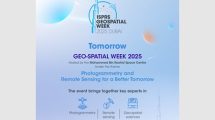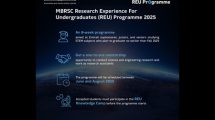 Representatives from Mohammed bin Rashid Space Centre (MBRSC) have presented a keynote entitled “Space for man’s happiness and enriching human knowledge” at the International Conference for Future Governments held at the fourth edition of Dubai International Government Achievements Exhibition (DIGAE) organised by the Dubai Government Excellence Program (DGEP) of the General Secretariat of the Executive Council of Dubai, under the patronage of His Highness Sheikh Mohammed bin Rashid Al Maktoum, UAE Vice President and Prime Minister and Ruler of Dubai, from the 11th -13th April 2016. Presented by Omran Sharaf, Project Manager of the Emirates Mars Mission, and Amer Al Sayegh, Project Manager of KhalifaSat, the keynote showcased the objectives and services of the two hugely significant space projects in the UAE currently being developed at MBRSC – The Emirates Mars Mission and KhalifaSat. Sharaf and Al Sayegh highlighted the latest developments involving the two projects.
Representatives from Mohammed bin Rashid Space Centre (MBRSC) have presented a keynote entitled “Space for man’s happiness and enriching human knowledge” at the International Conference for Future Governments held at the fourth edition of Dubai International Government Achievements Exhibition (DIGAE) organised by the Dubai Government Excellence Program (DGEP) of the General Secretariat of the Executive Council of Dubai, under the patronage of His Highness Sheikh Mohammed bin Rashid Al Maktoum, UAE Vice President and Prime Minister and Ruler of Dubai, from the 11th -13th April 2016. Presented by Omran Sharaf, Project Manager of the Emirates Mars Mission, and Amer Al Sayegh, Project Manager of KhalifaSat, the keynote showcased the objectives and services of the two hugely significant space projects in the UAE currently being developed at MBRSC – The Emirates Mars Mission and KhalifaSat. Sharaf and Al Sayegh highlighted the latest developments involving the two projects.
The meeting began with a presentation by Amer Al Sayegh, addressing the main objectives of KhalifaSat, which include Emiratisation of the development process of space systems. The foundations laid by KhalifaSat’s development will be an essential reference point for this sector in the UAE, where the satellite is being manufactured inside the UAE. Al Sayegh said: “The satellite development process is one of the most complex and difficult technologies.
Al Sayegh emphasised that KhalifaSat consolidates the leadership of Dubai Government and the UAE in developing advanced satellites, and has made the UAE one of the leading countries developing space systems. The project has also increased UAE investments in space and advanced industries.
Al Sayegh stated that KhalifaSat is the most advanced Arab satellite, with 0.7m high-resolution imaging, run by Emirati experts who develop and use the space systems, taking into account the international standards and the laws. He added: “The KhalifaSat project provides proof that the UAE has succeeded in stepping into the advanced technology industry in a very short period of time – just 10 years. It has also served as a launching pad for building the first satellite technology laboratories in the country, of the highest world-class standards. As such, the country has opened the doors to national oganisations providing services to the space sector locally, regionally and globally.”
Al Sayegh stressed that KhalifaSat is a major turning point in the development of modern satellite systems, it will offer competitive services globally through advanced Emirati innovations such as providing satellite images efficiently and quickly, introducing specialised studies and analysis, expanding the country’s database of satellite images, while improving imagery quality and promoting high efficiency in imaging, storing and guiding systems.”
He also mentioned that KhalifaSat is one of the smallest satellites in the world that offers sub-meter high resolution imagery, and is equipped with the biggest camera developed in MBRSC. The satellite will be capable of covering the whole area of Dubai in just one pass, thanks to its advanced guiding system.
During the presentation, Al Sayegh highlighted the evolving plans and projects launched by MBRSC to serve the needs of the UAE, which have made the Centre a regional leader in satellite services, stating that KhalifaSat represents the peak of its achievements. The satellite has been fully manufactured and designed at MBRSC by highly capable Emirati hands, and once in orbit will be managed by Emirati experts of programming, imaging, mechanical systems and electronics, in addition to the logistics and quality and project management teams.
“The Centre launches advanced programs for training and qualifying individuals, giving participants the ideal opportunity to excel in space science and technology and join MBRSC teams in 3-6 months, aiming to increase the number of specialised Emirati experts and adding a value to the sector,” Al Sayegh said.
In conclusion, he spoke of the progress made on the groundbreaking project so far: “The Emirati talents working on KhalifaSat have completed 70% of the overall project, and they are preparing the satellite to be launched into space by 2018 aboard the Mitsubishi H-IIA Rocket, from Tanegashima Space Center in the Japanese Tanegashima Island. These experts are not only capable of manufacturing and managing the satellite remote sensing systems and Earth observation, but are also participating in our outer space exploration project – The Emirates Mars Mission, the most prominent tasks entrusted to the Centre are the design, implementation, and supervision of all phases of launching the “Hope Probe” to explore Mars.
Omran Sharaf stressed that: “The UAE has developed an integrated, triangular space sector consisting of human resources, infrastructure and leading projects. The Hope spacecraft is being carried out under the leadership of an Emirati team, where members depend upon the skills, techniques and information they have gained from previous space projects. Today they are working hard to acquire the relevant knowledge of space exploration science. It is not an easy task, but we believe in achieving the goal of reaching Mars, strengthening the status of the UAE and promoting the spirit of hope, all motivate and drive us to make the necessary efforts to achieve our goal.”
He pointed out that: “The Emirates Mars Mission is strategically important, as it establishes a new era in the space sector in the UAE and reflects the state’s strategy to achieve its vision for the future of development, and to build a competitive economy based on knowledge and innovation.”
In a presentation, Sharaf addressed the importance of the space sector in the growth of the economies of other countries around the world, pointing to the experiences of major nations in this regard, as well as the technical discoveries resulting from space projects and their impact on economic growth and scientific progress. He said: “The results of space programs in other countries showed that there’s a payback of $7 for every one dollar invested in space, through technical discoveries, such as the invention of batteries and solar energy panels, among others. Such discoveries were developed for space exploration, but were then adapted for the benefit of humans in their daily life. Studies show that the expected growth of the global space industry is 8% per annum, and it’s valued at $300 billion.”
Sharaf also presented the Hope’s plan, stressing that “the work is going according to the timeline and we have reached an advanced stage of preliminary design. We also started working on the subsystems details, which will be completed at the end of this year, with the final designs to be reviewed in 2017. Then the manufacturing and testing phases will follow before launching the probe into outer space in 2020; the probe will reach the Red Planet in time for the UAE’s Golden Jubilee, celebrating the 50th anniversary of the founding of the UAE.
Sharaf explained the probe launching process, in light of MBRSC signing a contract with Mitsubishi Heavy Industries, Ltd (MHI) to launch the Hope Probe using the H-IIA rocket in 2020, from the company’s launch base in Japan. He said: “Hope will be placed at the top of the rocket and launched into space. The launch stage takes 54 minutes, where the rocket takes the probe out of the Earth’s atmosphere before the probe travels solo towards Mars.”
On choosing the launching company, Sharaf explained that the launching team in the project conducted a detailed study of the options available, and the decision was taken after reviewing the specifications of the rocket and the successes it has achieved previously. He said: “We are fully aware of the importance of the project, and reducing any risks is an essential aspect in any decision or step we take. The launch phase is a very critical and important stage and requires precision in taking decisions because the launch window only comes once every two years. Therefore, the team considered several criteria for evaluating the options available, including the success rate of the company’s launch attempts, which amounts to 96.7%. We also looked at the performance of the rocket, as the launch window increases with high performance, thus reducing any potential risk, in addition to the possibility of the separation of the rocket from the probe at a distance far from the Earth’s orbit, reducing the use of fuel and providing us with greater capacity to reach Mars orbit.”
On the Centre’s efforts in developing Emirati human resources specialized in Mars science, and developing their capabilities to extract information from the data that will be shared with the scientific community around the world, Sharaf said: “MBRSC continues its knowledge transfer strategy through a strategic program on Mars science and the associated technologies with the collaboration of academic strategic partners in the United States. This will provide the team of Emirati engineers with the opportunity to analyze the data Hope Probe sends back to the Centre’s ground station in the UAE after it reaches the Red Planet. In addition, the scientific team is being trained at the Centre on the foundations and techniques of the analyzed data and conducting related studies and research.”
Sharaf concluded saying: “The Hope Probe is the first Arab and Islamic project of its kind to explore another planet. The country’s decision to share data with the science community interested in exploring Mars highlights its commitment to contributing to the enrichment of human knowledge. This project opens the doors of hope and optimism to the Arab youth and the Arab world in general, and reinforces the region’s capacity to produce human knowledge and to serve humanity.”














Add Comment